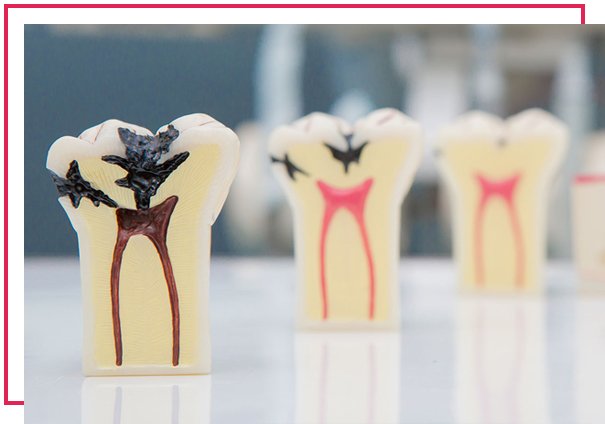
What is endodontics?
Endodontics, tooth the live tissue of the nerves and blood vessels (pulp) and surrounding tissues for diagnosis and treatment of problems of the far is the branch of dentistry that deals with problems with.

Why is endodontics important?
Every human has bacteria in the oral cavity. They do not harm unless undesired conditions are created. Bacteria combine with many of the food we bring to provide the formation of acids in our mouths. If we do not remove these formed acids from our mouths, these substances will damage the enamel and cause the caries to grow on the enamel. If the cavities formed in the enamel are not treated, the enamel layer pass to the dentin layer. Although the dentine layer stimulates us with pain, if the cavity is not treated again, the microorganisms move towards the pulp. During this time, the pulp activates various ways to protect itself. One of these ways is to warn us by pain. But if we do not treat our teeth again after a while, microorganisms destroy the vessels and nerves inside the pulp and cause inflammation.

What treatments does endodontics perform?
• Root canal treatment
• Endodontic surgery applications
• Prevention of pulp diseases and live pulp treatments
• Differential diagnosis and treatment of mouth and face pain caused by pulp and periapical tissue
• Repetition of root canal treatment in endodontic failure (retreat)
• Whitening of endodontic treated teeth
• Treatment of dental trauma
• Support endodontic treatments for prosthetic, periodontal and orthodontic treatments
• Post placement in root canal cavity for Kuronal restorations

Why does the inflammation occur in pulp?
Bacteria combine with many of the food we bring to provide the formation of acids in our mouths. These acids cause damage to the tooth enamel if we do not give importance to our oral hygiene and cause the caries to develop on the enamel. If the cavities formed in the enamel are not treated, they pass to the dentin layer beneath the enamel layer. Although the dentine layer stimulates us with pain, the microorganisms move towards the pulp if the cavity is not treated again. In the meanwhile, the pulp warns us by means of pain to protect itself. But if we do not treat our teeth again after a while, microorganisms destroy the vessels and nerves inside the pulp and cause inflammation. Another way to develop inflammation in the pulp is trauma. A pulse causes the veins and nerves to enter the root of the tooth from the root end, thus causing the tooth to lose its vitality. Addition of microorganisms by this way causes inflammation of the pulp. Another way in which the pulp is infected is the presence of long-term periodontal (gingiva and surrounding) disease around the tooth. Source: Painful tooth may be a precursor to inflammation!

What is the treatment modelity process?
• Detection of the problematic tooth by radiography,
• If the tooth is alive, local anesthesia is done to eliminate the sensitivity in the teeth and surrounding tissues,
• Forming the gap to reach the pulp by cleaning the cavities in the enamel and dentin layers,
• Isolation of the teeth by plugging rubber dam,
• Determining the length of work using electronic equipment and confirming by radiography,
• Destruction and removal of the microorganisms in the root canal of infected dentin layers using rotary tool systems,
• Removal of microorganisms with various root canal disinfectants when using rotary tool systems in root canals,
• Waiting for a certain time with a canal antiseptic to be placed in the root canal and to fill the root blood in the next meeting when starting the root canal operation if the tooth is not alive.

What is the success rate?
After the root canal treatment, it is aimed to repair the tooth by cutting off the surrounding tissues, in order not to the infection occur again and damage in the surrounding tissues of the tooth. Root canal treatment is performed under local anesthesia and no pain is heard.
Following the root canal treatment, especially after the treatment of live teeth, the tooth may develop a folding pain for several days, or when pressed on the tooth. This is a normal pain after treatment. The root of the root canal treatment is eliminated with a little protection. The success rate of canal treatments is 90%.

What is root canal treatment?
It is used in cases where the nerve (pulp) in the inner part of the tooth cannot heal or dies due to caries or trauma. The remaining teeth in the oral canal treatment will be dead in that area, but at least will continue to help chew as your own tooth, thus preventing the melting of the jaw bones with the active bone in that area.

What is laser root canal treatment?
The laser is a linear moving beam having the condensed energy produced by an electromagnetic light amplifier. In dentistry, this energy is used to break up tissue by evaporating water molecules in tissues. Laser surgery can be performed without bleeding. Small interventions do not require anesthesia.It saves time both during operation and in recovery period.





